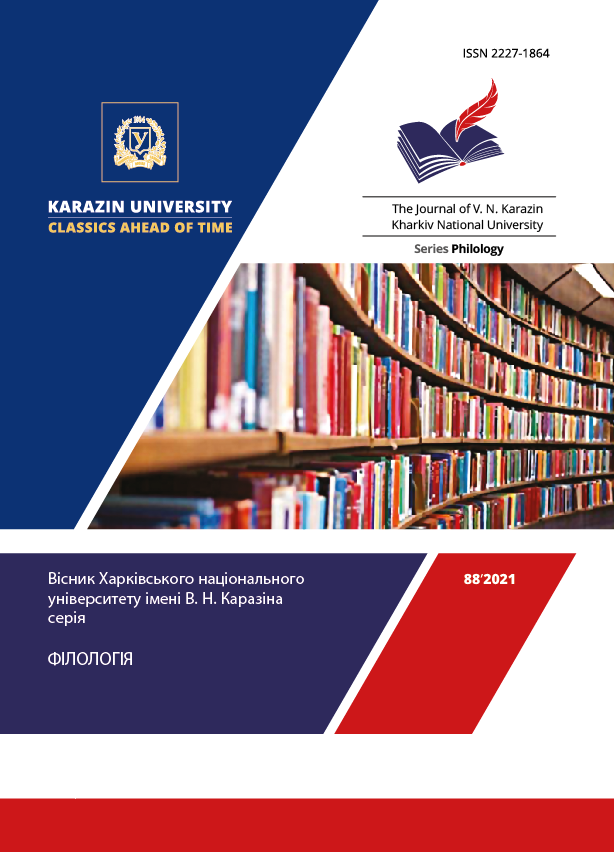Кольорова синестезія в сучасній жіночій поезії
Анотація
У статті проаналізовано вияви синестезії у поетичному мовленні сучасних мисткинь. Відсутність спеціальних досліджень синестетичної мовної репрезентації в сучасних поезіях зумовлює актуальність запропонованої розвідки. У науковому трактуванні синестезія – це взаємодія слів на позначення емоцій або інших абстрактних чи конкретних понять. У мовознавстві поняття «синестезія» використовують на позначення механізму метафоричної аналогізації, сформованої на основі зорових, смакових, слухових, одоративних, тактильних відчуттів людини, які постачають власні одиниці на позначення інших концептуальних сфер. У сучасній поезії продуктивною є синестезія як засіб вербалізації суб’єктивних переживань, активно вживаними при цьому в поезії постають ахроматичні кольори (білий, сірий, чорний). Часто вживаними постають також лексеми на позначення відтінків синього кольору (синій, блакитний, голубий), що асоціюються з поняттям меланхолії. В аналізованих поезіях переважає кольорово-звукова синестезія, що пояснюємо фізіологічною значущістю візуального та аудійного каналів для отримання інформації, а також жанровою специфікою аналізованих текстів. На синтаксичному рівні традиційною моделлю синестетичного словосполучення є поєднання ад’єктивного кольоратива із субстантивною лексемою на позначення поняття іншої концептуальної сфери. Розташування означення в постпозиції до означуваного слова надає синестетичним конструкціям додаткової стилістичної значущості, підсилює їхній експресивний потенціал. Рідко вживаною синтаксичною моделлю синестезії є використання складних ад’єктивів у функції подвійних епітетів. Подекуди синестезія стає твірною основою цілої поезії. Аналіз синестетичних конструкцій дає змогу осягнути глибинний внутрішній світ поетес, особливості поетичного мислення, українського світобачення загалом.
Завантаження
Посилання
Аrutyunova, N. D. (1979). Yazykovaya metafora (Sintaksis i leksika). Lingvistika i poetika. Moskva. 164–170.
Voronin, S. V. (1982). Osnovy fonosemantiki. Leningrad: Izd-vo Leningradskogo universiteta. 244 s.
Galeev, B. M. (1999). Sinesteziya – chudo poeticheskogo myshleniya. Nauchnyj Tatarstan, 3. URL: http://synesthesia.prometheus.kai.ru/sine_r.htm (data zvernennia 12.08.2020).
Zhuravlev, A. P. (1974). Foneticheskoe znachenie. Leningrad: Izd-vo Leningradskogo universiteta. 160 s.
Zabuzhko, O. (2009). Druga sproba: Vy`brane. Kyiv: Fakt. 432 s.
Korpus ukrayins`koyi movy. URL: http://www.mova.info/corpus.aspx (data zvernennia 12.08.2020).
Levickii, V. V. (1994). Foneticheskaya motivirovannost’ slova. Voprosy yazykoznaniya, 1, S. 26–37.
Malovic’ka, L. (2009). Zvuk і kolіr: fenomen sinestezіi u tvorchomu mislennі genіya-mitcya. Aktual’nі problemi suchasnoї fіlosofіi ta nauky: tvorche, krytychne і praktychne myslennya. Zhitomir: Zhitomirs’kii derzhavnii centr naukovo-tekhnіchnoi і ekonomіchnoi іnformacіi. S. 55–58.
Minich, L. S. (2013). Synestezijni vyyavy u tvorax M. Vingranovs`kogo. Naukovi zapysky Nacional`nogo universytetu «Ostroz`ka akademiya». Seriya: Filologichna, 34. S. 157–158.
Potebnya, A. A. (1993). Mysl’ i yazyk. Kiev: Sinto. 191 s.
Sama. Antologiya suchasnoyi zhinochoyi poeziyi. (2013). Kyiv: Presa Ukrayiny. 320 s.
Ul’man, S. (1970). Semanticheskie universalii. Novoe v lingvistike, 5. S. 279–281.
Uorf, B. (1960). Otnoshenie norm povedeniya i myshleniya k yaziku. Novoe v lingvistike, 1. S. 163−164.
Shamota, A. M. (1967) Perenosne znachennya slova v movі hudozhnyoi lіteratury. Kyiv: Naukova dumka. 127 s.




